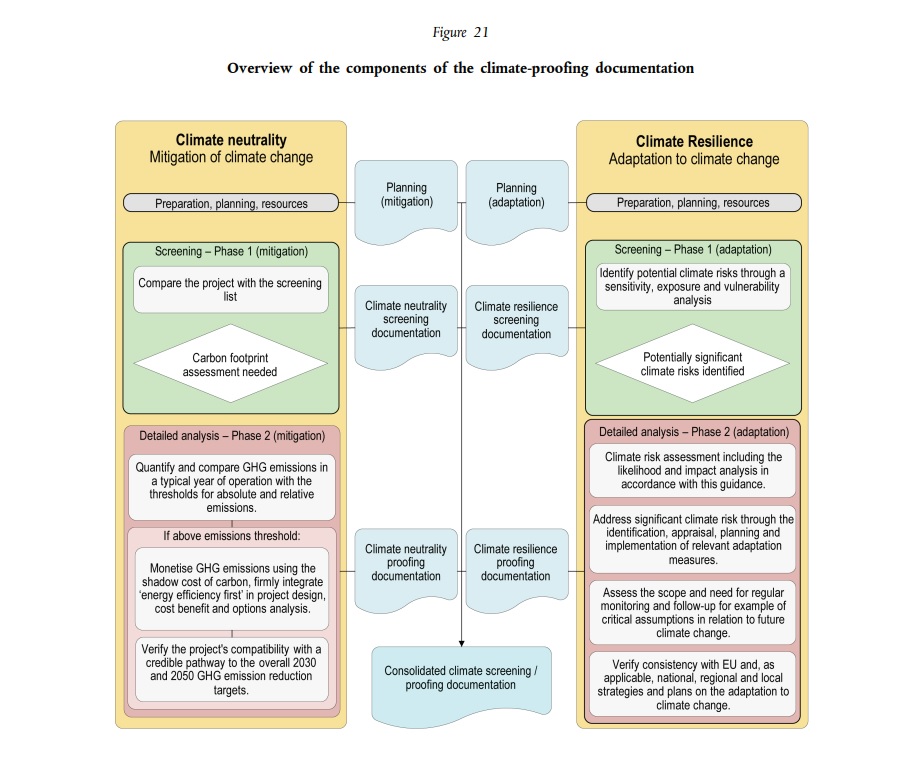Climate Proofing
Our Service Areas
Corporate Sustainability & ESG
Understanding Climate Proofing: Benefits and Importance for Infrastructure Development
In general terms, climate proofing is a process that integrates adaptation aspects to the development of new infrastructure. Climate proofing is not only about analyzing the impacts your business will have on the environment, but also about the impacts a changing environment will have on your business and its continuity. In addition, by doing climate proofing properly, your business can access different financial benefits: climate proofing is a requirement for many funding and loan instruments within the European Union.
Infrastructure built today will last decades into the future so it is essential that the future changes in the environment are properly accounted for already at the beginning of a new infrastructure project. In 2021 the European Commission introduced a Technical guidance on the climate proofing of infrastructure in the period 2021-2027 (2021/C 373/01), which brings together the requirements of several different EU funding and loan instruments and combines these into an integrated technical assessment process referred to as climate proofing. The guidance enables European institutional and private investors to make informed decisions on infrastructure projects that qualify as compatible with the Paris Agreement.
The Regulatory Basis for Climate Proofing in the European Union
The Commission’s technical guidance on climate proofing relates to several different EU funding instruments and the requirements arising from them. The most relevant infrastructure funding instruments which may be employed include the InvestEU Programme, Connecting Europe Facility (CEF) and – under the Common Provisions Regulation (CPR) – the European Regional Development Fund (ERDF), the Cohesion Fund (CF) and the Just Transition Fund (JTF).
- InvestEU:
Recital 13 of the InvestEU Regulation refers to the screening and proofing of investment projects and mentions that the accompanying guidance shoud be consistent with the other programmes of the Union. The guidance should appropriately use the Taxonomy Regulation and the principle of do no significant harm (DNSH). The InvestEU’s sustainability guidance specifies a threshold of 10 million exclusive of VAT for sustainability proofing.
- Connecting Europe Facility (CEF):
According to the CEF Regulation recital 5, projects supported by the CEF should be subject to climate proofing, where relevant, in accordance with the guidance developed by the Commission.
- Common Provisions Regulation (CPR):
According to CPR, 10 the funds should support activities that are in line with the do no significant harm principle. Adequate mechanisms to ensure the climate proofing of supported investments in infrastructure should be a central part of the implementation of the funds. The Regulation also stipulates that the managing authorities should ensure the climate proofing of investments in infrastructure with an expected lifespan of at least five years.
The Process
In the technical guidance, the process of climate proofing is divided into two pillars (mitigation, adaptation) and two phases (screening, detailed analysis). Both pillars need to be screened. If the screening results indicate that a detailed analysis is warranted, the process moves into the second phase.
Mitigation
Phase 1: Screening
Phase 2: Detailed Analysis
The GHG emissions of a typical operational year are calculated. The absolute and relative emissions are compared to threshold values given by the guidance. If the values are exceeded the following steps need to be taken:
- The GHG emissions need to be monetized by using the shadow cost of carbon methodology and integrating an energy efficiency first principle.
- The project’s compatibility with a credible pathway to achieve the overall 2030 and 2050 GHG emission reduction targets has to be evaluated.
Phase 1: Screening
Phase 2: Detailed Analysis
The climate risks and their likelihoods are assessed and relevant and suitable adaptation measures are planned and implemented. The scope and need for regular monitoring is assessed in relation to future climate change and the project’s consistency with EU and national or regional strategies and plans on the adaptation to climate change.
At the end of phase 2 the documentation is compiled and the analysis summarised in a climate resilience proofing statement.
What Do We Offer?

DGE was among the pioneering environmental consultancies to conduct climate proofing assessments in Northern Europe. As one of our first projects in the service area, we conducted a climate proofing assessment of a rare earth metal magnet manufacturer in Estonia.
Since then, we have swiftly built a solid reputation for assisting businesses in incorporating this process into their projects. Our collaboration with government officials and regulatory bodies has allowed us to effectively implement these standards in practice. We are well-equipped to guide our clients in meeting the expectations set by the EU’s technical guidance.
DGE Finland offers comprehensive climate proofing services that help our clients navigate through EU regulations and technical guidance. We offer assistance in various industries with the following services:
- Climate Proofing Consultation: We offer consultation services to help clients understand the requirements for climate proofing, as well as the necessary steps to ensure compliance with EU funding and loan instruments.
- Mitigation and Adaptation Planning: We help clients develop effective mitigation and adaptation strategies to reduce their projects’ environmental impacts and increase resilience to climate change.
- Screening and Detailed Analysis: DGE Finland can conduct the required screening and detailed analysis for both mitigation and adaptation aspects of a project, ensuring that all relevant risks are identified and addressed.
- Documentation and Reporting: We help clients compile the necessary documentation and create climate proofing statements as required by the EU technical guidance.
- Monitoring and Evaluation: We establish a monitoring and evaluation plans to track the effectiveness of climate proofing measures and adapt to evolving climate risks.
At DGE Finland, we believe that climate proofing can act as an important motor of the green transition in Europe. By choosing us as your environmental consultancy partner, you can trust that you will receive close guidance and support throughout the climate proofing process, ensuring that your project meets the highest environmental standards and benefits from the financial opportunities available through EU funding and loan instruments.
Resources:
Where to start?
We have gained solid experience from the area of sustainable financing
and the application of EU guidelines in complicated projects.
Don’t hesitate to contact us and ask for more information!
Udvalgte referencer



